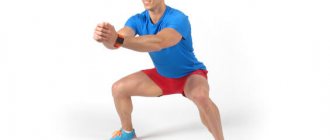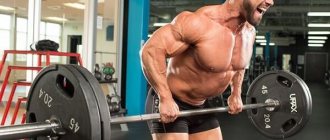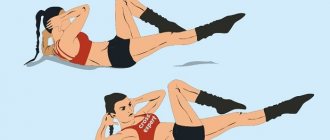Front squats are one of the rarest exercises in any sports club. The reason is not at all that no one knows about him, rather, on the contrary. Many people simply do not like to perform a peculiar exercise, so athletes are very reluctant to add it to their training program. However…
The front squat is a basic exercise that engages as many muscle groups of the body as possible. However, in order to realize all the benefits of its implementation, you need to learn more about it and consider in detail the features of its implementation.
Benefits of Exercise
A distinctive feature of this type of squats is the location of the bar, which is unusual for many athletes. Unlike the more standard version, the barbell is placed on the chest and deltoids, and not on the back muscles at all.
This variation results in the back being in an almost vertical position, which radically changes the load on the body. And the muscles that are involved in the work change radically.
What muscles work:
- The main work is done by muscle units such as quadriceps.
- The auxiliary muscles are the gluteus maximus, gastrocnemius, soleus, posterior thigh muscles, as well as the rectus and oblique abdominal muscles.
Thus, there are a huge number of advantages in using this type of squats:
- An undeniable help in building well-developed thighs, a strong lower back and strong abs.
- Reducing the compressive effect on the spinal column, and therefore on the entire back, minimizing knee injury.
- Lack of lumbar torque.
- There is a high probability of performing the exercise with the correct technique. Otherwise, the barbell will immediately fall to the floor and you won’t be able to squat. And mastering the correct technique is crucial in any athlete’s training cycle.
- Formation of impressive core muscles, development of more reliable stability.
- If a plateau occurs when training your legs, it easily eliminates this problem, literally exploding muscle growth.
- Promoting better fat burning.
Common Mistakes
The first mistake you can make due to inexperience is to look up or down during the exercise. As mentioned above, you need to look directly. Otherwise, there is a risk of losing balance and falling. As a result, in addition to psychological discomfort, you can damage your knees, since you will have to fall forward.
You can also lose the barbell during an exercise due to an uneven back. When it is indirect, the load is distributed incorrectly and there is a risk of injury or falling.
Reducing the squat amplitude can also interfere with the desired effect. Some beginners, in an effort to reduce the load, do not squat deeply enough. As a result, the quadriceps does not receive full load. But in this case, there is initially no point in doing such an exercise. You need to squat deeply - this is an uncompromising rule.
Working weight exercise
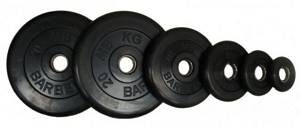
Considering that this exercise is basic, it does not tolerate weak or lagging muscles. This means that if you want to increase the weight of the projectile, all the shortcomings of the technique can come out due to lagging links in the form of individual muscle groups.
Therefore, the weight on the bar will be 25%, and maybe even 50% less than in classic squats.
It depends on whether you performed a full descent to the bottom point or not. For example, if your weight was 100 kg in the classical form, and you squat below parallel, the barbell weight on the chest could be 85 kg. If not, it’s better to take 50 kg.
This huge difference is due to the fact that with regular squats the amplitude is partial. There is nothing terrible or shameful in this; work progress will not slow down. After all, better hip development will be achieved while minimizing injury. The barbell squat improves glute activation and allows for greater squat depth.
Correct technique
The mechanics of this exercise are such that many technical flaws inherent in conventional squats are simply impossible here. If an athlete begins to twist his back, he will simply lose his balance and fall.
You cannot perform this exercise with a crooked back, you simply will not stand up with the barbell in this position, while regular squats allow such hackwork.
Therefore, on the one hand, front squats are simpler: the correct technique here will have to be followed in any case. But on the other hand, they are complex: the athlete will not be able to simplify his task by slacking in technical details.
The algorithm for performing the exercise is as follows:
- Place the barbell on the racks, the height of which should be equal to the level of your shoulders.
- Sit under it and grab it with your hands shoulder-width apart. The legs should also be approximately this width. The feet are parallel to each other or diverge very slightly to the sides.
- The starting position should be such that your arms are parallel to the floor; to do this, you need to bend your hands and wrists.
- If you are using dumbbells, place your right hand on your left shoulder and your left hand on your right, placing the dumbbells on your shoulders accordingly (the same grip can be used when performing an exercise with a barbell).
- Get up from this position so that the bar lies between the bottom of your neck and the top of your chest and is supported in this position by your hands.
- Take a couple steps back.
- Squat down to a position where your legs are parallel to the floor. Stand back up. Repeat 5-10 times. You need to sit down while inhaling, get up while exhaling.
Analysis of errors and recommendations
Despite the fact that it is difficult to make mistakes here, typical of a classic squat, some violations of the technique are still possible.
First of all, these include incorrect head position . The gaze should be directed only in the forward direction. Otherwise, there will be unwanted stress on the cervical vertebrae. In addition, if you look down, your back will bend in that direction along with your head.
The perpendicular from the bar to the floor should be in the middle of the foot . Otherwise, the load will be distributed incorrectly. Many beginners move their body too far forward, causing the bar to be positioned far ahead of the floor rather than above their feet.
Of course, you don’t need to make any geometric calculations, but when determining your body position “by eye”, you should not allow such a location for the projectile.
You shouldn’t overly “wring” your wrists unless you have good stretching (which, by the way, plays a much larger role in front squats than in regular ones). If you can't keep your arms parallel to the floor without pain in your elbows or wrists, then it's better to stretch them and don't force your joints with premature loads.
The pelvis and abdomen should be pulled forward throughout the entire exercise; you should not pull them back, trying to maintain balance - this will only upset it.
A general rule for all squats, and front squats are no exception: at the top point you do not need to straighten your knees completely . Firstly, it overloads the joints, and secondly, it relieves stress from the muscles. And the muscles should not be allowed to rest between repetitions; this is possible only after completing the approach.
It is a mistake to hold the barbell suspended using just your arms . The bar should lie on the chest, and the hands should only secure and stabilize its position.
Incorrect tempo of execution is a consequence of the greater complexity of measured and gradual movement. At a fast pace, you can try to lift more weight, but this does not benefit the body, and it is very easy to violate the correct technique.
You can’t bring your legs together at the knees , this dramatically increases the risk of injury. If you cannot keep them in the correct position, then the weight on the bar is too much for you, reduce it.
It is easier to control the position of your back and head if you squat in front of a mirror.
How to do a front squat?
The most important condition for performing any kind of exercise is not its aesthetic beauty, not the record weight you lift, but the correct technique.
In order to master squats with a barbell located on the chest, you need to gradually perform the following steps:
- Use a power rack. To do this, approach it and make the height of the racks convenient for you personally. The classic option is at the height of your own shoulders. Next, place the barbell on the racks and place the required number of weights.
- Step forward with one foot and tuck your shoulders under the bar. After crossing your arms, place them on the top area of the barbell. The location of the elbows must be strictly parallel to the floor. After removing the bar, take the reverse step.
- The initial position of the feet is shoulder-width apart, the toes turned 30-35 degrees. The abdominal muscles remain tense. This is the position from which the exercise starts.
- Before squatting, be sure to straighten your back and place your feet firmly on the floor. Next, slowly, while inhaling, begin squatting until your thighs are parallel to the floor. If you get a deep squat without compromising your technique, do it. The gaze is directed in the direction of movement.
- After pushing hard through your heels, straighten your legs and return to the starting position. Perform the specified sequence as many times as necessary.
In addition to the classic version of the squat with a free weight in the form of a barbell, there may be the following options:
- Using dumbbells or weights. This is an excellent option for girls who are interested in adjusting their legs, rather than intensive mass gain, and beginners who are just mastering technique and a sense of balance.
- Using a Smith machine. The principle of performing the exercises is the same as with free weights. However, Smith squats provide additional control and safety.
Other Squat Variations
Barbell squats are basic. But there are other variations.
Smith Front Squats . The technique for performing squats in a Smith machine is the same as in a power rack. But the simulator will provide greater safety and control of movements. Thanks to this, this version of the squat is better suited for beginners - there is no danger that during the squat the bar will slip or an injury will occur.
Front squats with dumbbells . You can also use weights. This option is well suited for girls who do not want to gain excess weight, but want to tone their legs. The method is also well suited for beginners who are just mastering the technique and need to improve their balance.
When performing a squat, dumbbells are taken with a regular grip; there is no need to cross your arms. Shoulders need to be set wider. Palms point upward; elbows should not be spread to the sides. It is best to do the exercise in front of a mirror to accurately see the correct technique. It is important not to forget that the result and effectiveness of the training depends on the correct technique.
It is also recommended not to fully extend your legs on the way up, leaving them slightly bent at the knees to reduce the load on the joints.
Front squat with dumbbells
This squat is much better than the classic squat for several reasons:
- – involves the largest number of core muscles;
- – this method allows you to squat much below parallel;
- – with this squat, the weight is better regulated.
There are several techniques for front squatting with dumbbells.
- You need to sit down as low as possible, you must not lift your heels off the floor and your back must be straight, you must bend your arms at the elbows and let the dumbbells touch your chest, you must create a load on your arms while holding the dumbbells suspended, you must place the dumbbells on the upper chest, holding them with your hands.
- The second option is similar to the first, the only difference is that the dumbbells should not be placed on the chest, but held on outstretched arms. The most important thing is to keep your back straight, otherwise your back may round.
There is also a third option for squats with dumbbells with a wide stance.
The essence of the exercise is that the legs should be placed wider than the shoulders, and the dumbbell should be held at outstretched arms. The rest is done exactly the same as in the first two options.
For the exercise of the previous option, you need one dumbbell and its weight should correspond to what you can hold.
The advantage of such exercises is stretching of all muscle groups involved.
Practical advice
The front squat is an exercise that can be performed without a barbell, although its use is a priority. It is replaced with dumbbells, which need to be taken with a regular grip, without crossing your arms. At the same time, you should straighten your shoulders a little wider. The palms should be directed upward and the elbows should not be spread to the sides.
It makes sense to perform this exercise in front of a mirror, it makes it easier to practice the squat technique. Moreover, special emphasis needs to be placed on it (the technique), since the result directly depends on the correct execution of the squat.
At the final stage of the exercise, during the upward jerk, you should not fully extend your knees in a standing position. This will take the stress off the hip and transfer it to the joints. Therefore, at the extreme point of lifting, you need to leave your knees slightly bent, maintaining the load on the muscles.
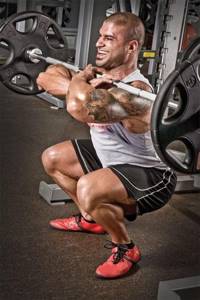
As for the number of repetitions, each person must calculate them individually. But if we talk about average standards, then you can start with 3 sets of 6-12 repetitions, depending on how you feel.
Single leg front squat
One of the best variations of barbell squats is the scissor squat and single-leg lunge.
To perform these exercises, good coordination of movements is required. It is not recommended to immediately move on to the barbell. It is best to start doing such exercises with dumbbells, or with minimal load on the body.
The difference between scissor squats and lunges is that when lunging, you need to take a step forward and maintain balance with a straight back.
When using the scissor squat technique, you need to stand as straight as possible, holding the barbell on your shoulders. You need to take a step forward, touching the floor with one knee. Next, pushing off with the heel of the front leg and the toe of the back leg, we take the starting position.
After each approach, you need to take a break so that your breathing is restored and you can begin a new set of exercises.
Squats to lunges are similar, the only difference is that you need to take a step forward and return to the original position.
Key points
FEET POSITIONING.
Classic position - feet shoulder-width apart, toes slightly turned to the sides. Be sure to ensure that your heels do not lift off the floor. If you put pancakes under them, this is not correct and does not solve the problem. The heels must be absolutely motionless and parallel to the floor.
NECK POSITION.
The bar should be positioned on the trapezius in the area of the rear delts. The closer the bar is to the neck, the more dangerous it is. Excessive pressure is created on the spine. The bar should not be too low because sometimes this leads to shoulder injury.
GRAB.
It is better to hold the barbell with a classic, closed grip, that is, with the thumb opposite the index finger, and not next to it.
The grip width is not particularly important, the main thing is that you are comfortable. Well, the obvious thing is to take the bar in the center so that one side does not outweigh.
HEAD POSITION.
You need to look in front of you, slightly raising your head just above the horizon line. If you look at the floor, your neck will automatically fall, and this is wrong. When working with heavy weights, this can lead to injury and overload of the spine.
Should I choose a front squat or a regular squat?
People who are just starting to train with dumbbells and barbells have a question: is it better to choose a front squat or a regular one?
For beginners, it is best to start with a regular squat and gradually move up to weights and front squats. However, many coaches believe that the second option is the best for several reasons:
1) Firstly, more muscle groups are involved, and all muscles are tensed equally. On the other hand, the front squat can be difficult for people who have back problems or are unable to lift weights.
2) The front squat improves back posture. The fact is that the weight of the bar allows you to keep your back in a level position and squat so that your back is always straight. Moreover, you must also get up to the starting position with your back straight.
3) Barbell squats improve coordination of movements. One of the most important aspects of squats is coordination. An incorrect stance disrupts the condition and a person may fall along with the weight he is holding.
4) Barbell squats allow you to improve muscle stretching and develop stamina.
Errors allowed
Although it would seem that there cannot be a priori mistakes when performing front squats, they do happen:
- movements are performed too quickly, i.e. jerkily. This makes it difficult to fully use the leg muscles, i.e. reduces the productivity of front squats;
- blocking the knees, i.e. in a standing position, their full extension. This relieves tension from the quadriceps, but increases the load on the joints;
- deviation of the back and head from a straight line leads to a fall of the projectile or a tilt of the body;
- incomplete use of the amplitude slows down the growth of muscle fibers due to their incomplete use;
- the execution technique is disrupted when using excessive weight;
- You need to hold the projectile with the strength of your wrists and hands.
Main mistakes made
It may seem to many that there are no difficulties and everything is so easy that strict control of the technique and its periodic recall are not even worth attention. However, this is not entirely true. Errors are quite common even among experienced athletes. Among them are the following:
- Perform the exercise quickly and jerkily. In the pursuit of speed, the necessary measured rhythm, which is simply necessary to engage all the muscle fibers of the legs and buttocks, completely disappears.
- Full or partial blocking of the knees. It should be noted that straightening the knees in a standing position removes the load from the quadriceps muscle and transfers it to the joints, which is not very useful and promotes progress, and it can also lead to unwanted injuries.
- Incorrect position of the head and back. If these parts of the body cannot stay straight without deviation, the body tilts forward or the barbell falls to the floor.
- Limitation of range of motion. This results in muscle fibers not being used to their maximum capacity, which slows down overall muscle growth.
- Incorrectly selected working weight. If you want to take record-breaking weights or perform squats with a weight similar to classic squats, the execution technique completely breaks down.
- Holding the barbell with the strength of your arms and wrists. Such excessive wringing quite simply becomes the cause of a rather painful sprain or dislocation. The ideal bar placement is with the deltoids in front, the elbows in front, and the wrists just helping to support the weight.
- Incorrect distribution of the total load. The horizontal axis of movement of the bar passes through the very middle of the foot. Compliance with this condition ensures the optimal level of back tilt.
Working muscles and joints
According to research results, it can be noted that front squats are optimal for working the rectus femoris and vastus lateralis muscles. The exercise is dangerous for the knees, so it cannot, for example, be performed during the rehabilitation period after an injury to this part of the body!
The gluteal, calf and hamstring tendons work as auxiliary muscles during the exercise. The soleus, gluteal and adductor muscles act as synergistic muscles. The calf muscle, as well as the muscles of the back of the thigh, act as dynamic stabilizers. Antagonists-stabilizers are the oblique abdominal muscle and the rectus abdominis muscle.
“Front” squats have a number of benefits that cannot be seen in the video:
- Promotes the formation of powerful thighs and a strong lower back, and works the abdominal muscles.
- Partially relieves the load from the lower back and has a gentle effect on the knee joints.
- Staying upright while doing a squat allows you to avoid tilting your back, which can lead to injury.
- Helps create less torque on the lower back.
- They are distinguished by a simple technique of execution.
- Allows you to build muscle mass and improve the athlete’s coordination.
- Helps burn calories.
How to squat with a barbell on the front?
Front squats - correct technique:
- Stand close to a power rack and set the height of the racks to shoulder height. Place the projectile on the frame, add the required number of pancakes.
- Stand under the barbell, cross your arms and place the apparatus on them (a weightlifter's grip is also possible), while keeping your elbows parallel to the floor, remove the bar from the racks and step back.
- Stand near a power rack, place your feet shoulder-width apart, tighten your abdominal muscles.
- Keep your back straight, rest your heels on the floor, and while inhaling, smoothly begin to perform front squats.
- As you exhale, return to the starting position.
You can also perform squats with a barbell in front in Smith (video on the website). The technique will be similar, but in this case the simulator will be a guarantee of safety! Alternatively, you can replace the barbell with dumbbells or kettlebells.
Main mistakes:
- The movements are performed quickly, without observing rhythm, which leads to the involvement of not all muscle fibers of the legs.
- Knees become locked - the final straightening of the knees leads to additional stress on the joints.
- The head and back are in the wrong position, which can cause the body to tilt and even cause the projectile to fall.
- Limitation of the amplitude of movement, which leads to a slowdown in the process of overall growth.
- Incorrectly chosen weight, which negatively affects the execution technique.
- Holding the projectile using the wrists.
Practical advice - the right equipment
An athlete's equipment is half the success of a workout! It is very important to choose the right clothes and shoes. The latter should have a small heel and a flat sole
You cannot lift a barbell in regular soft running shoes! As for clothing, it is better to choose one that absorbs moisture well and will not allow the barbell to slip. Additionally, you can prevent slipping by using talcum powder or chalk applied to the chest and neck area for better contact of the bar with the body.
Why front squats?
Almost everyone who chooses to achieve perfection through the gym knows that it is best to gain muscle mass by working with iron, performing classic presses and deadlifts. But not all
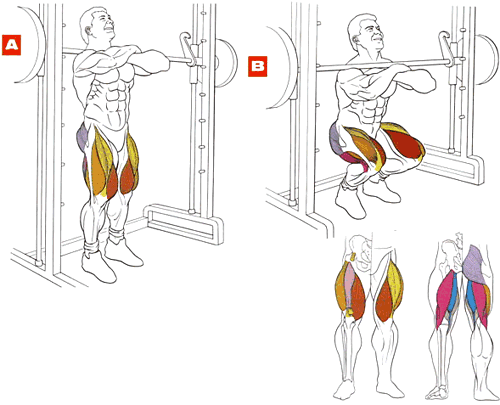
understand that these exercises will not tolerate a weak body and will require special training! Even if with small weights it was possible to do everything correctly and without failures, as the weights increase, technical flaws will begin to emerge, which will primarily be associated with the weakness of the athlete’s muscle groups.
Front squats are not safe in this case; just like the classic back squat, they require a lot of joint mobility and strong knees! In addition, a significant role is played by the fact that it will be possible to work with the barbell in front with lighter weights, while guaranteeing activation of the glutes and maximum range of motion.
In conclusion, front squats are a suitable option for both guys and girls who want to work on building their quadriceps. Study the video on the site and learn how to do the exercise correctly!
About the benefits of the front squat
Squats with a barbell and dumbbells have a number of advantages over other exercises:
- a large group of muscles is involved and the hips develop well, the lower back and abs improve;
- reducing the load on the back, which prevents knee injury when squatting;
- the possibility of correctly performing the technique, otherwise the bar will begin to fall and an attempt will occur to hold the weight with your back, which will result in a correspondingly greater load on the back and possible fractures of the spinal vertebrae;
- development of stability of movements and formation of muscle performance;
- promoting better and faster fat burning and tightening of the involved muscles.
All of these advantages allow athletes to choose these exercises, and coaches to use these exercises when drawing up a training plan. Girls can also do the front squat, as it is an excellent option for losing weight. The main thing is to choose the right weight.
Chips: the right equipment
A fairly small number of people pay due attention to such important details as clothes or shoes. Although these are not unimportant components of each training provided. For squats of any kind, as well as lunges, it is recommended to choose shoes with a thin heel, which means a low heel. Shoes with a smooth surface, soft sneakers or sneakers are not suitable here.
To give additional stability to the body and comfortable balancing, you need to use wooden plates or pancakes. They should be placed under your heels. This is a particular plus for people with flat feet.
An important point is the placement of the hands on the bar. After all, they can be held not only crossed, but also with a regular grip. We can say that most beginners will not like the crossed style. After all, it is difficult to constantly control the parallel position of the elbows relative to the floor, and at the moment of instability, the barbell may roll off. In the classic position, performing the exercise will be easier and safer.
Regarding clothing: the material of manufacture should perfectly absorb excess moisture and not be slippery. To prevent the bar from sliding, talk or chalk is used, which is applied to part of the chest and neck, which will improve the contact of the bar with the body of the practitioner.
Description of the execution process
First, a small disclaimer. All the advice below does not claim to be “this way and no other way.” The reason for this is the individual ANATOMY of each person.
- Leg length
- proportions of the lower and upper body,
- flexibility in joints (shoulder and hip),
- condition of the buttocks...
All of this affects what technique a person will ultimately squat with. Therefore, in this case, only an experienced trainer can set your ideal technique in person. This will be much better than trying to do it alone using YouTube or articles like the one you are reading now.
No... Everything here is written correctly, but it’s not universal, you know? Therefore, I want you to not be fanatical about information from the Internet. But let's look at the basic technique of squats with a barbell on the shoulders.
Moving Down
We approach the racks and sit under the barbell. We take the bar with a lock grip. We place the barbell in the area of the rear deltas and smoothly remove the barbell from the racks. In this case, the chin tends to the chest, and the elbows look at the floor.
The back is absolutely straight, no sudden movements, especially at the moment of breaking the bar. At this moment, our spine suffers enormous axial compression.
Let's take a step or a few back. Some take one step, some take three. It's not that important. The main thing is not to go too far.
Feet shoulder-width apart, toes slightly pointed to the sides. I also advise you to draw in your stomach, which will give you additional stabilization. I always do this and freeze for a few seconds, trying to feel the tension in my belly. We begin to move down.
The buttocks move back, the knees do not protrude beyond the boundaries of the feet. With feet, this recommendation is only relevant for shallow squats and in the case of beginners (who are not yet able to squat deeply). This is not a hard and fast rule. Also, do not forget that the position of the feet relative to the knees depends on personal ANTHROPOMETRY.
In general, remember one cool idea - there are no rules, there are PRINCIPLES! They need to be understood!
Keep your back straight with a slight tilt forward in order to minimize the pressure on the spine. If you do everything correctly, you will feel the work of the hamstrings, quadriceps, lower back and buttocks.
The width of your feet depends on your goals.
- A narrower one with parallel feet gives a targeted effect on the front of the thigh.
- But if you are a powerlifter, then a wide stance will suit you best, as it will allow you to lift more weight (the load here is more intense on the inner thigh).
Upward movement
The very first moment in this stage is the feeling of your heels. You must push off the floor with them and you must clearly feel it. I’ll tell you from experience, as soon as I started paying attention to the role of emphasis on the heels, my squatting technique instantly improved significantly. Therefore, be sure to take this factor into account, it’s cool.
Don't forget that when you go up, you need to exhale. Don't sit down or stand up abruptly, as some people do. There should be no springing moment at the bottom point!
6 unforgivable mistakes
- ROUND BACK. When an athlete’s back is weak and is not yet ready to support a lot of weight throughout the entire range of motion, it is usually rounded. This is a recipe for injury!
- FEET INWARD. They should either be turned outward or parallel (with a narrow stance of the legs), but not inward.
- MOVEABLE KNEES. During the upward movement, you cannot move your knees inward. One careless or too sudden movement and under the influence of the weight on your shoulders, a meniscus injury is inevitable. If you notice this in yourself, train your spinal extensors. Perform hyperextensions with weights, bends with a barbell.
- Naughty tailbone. At the lowest point, some make a movement in the lower back and lift the tailbone up, as if “pecking” it. This undoubtedly makes it easier to lift the weight, but it is also a sure way to injury.
- BREATH. A common mistake is improper breathing. For as long as people have written about this breathing, it’s embarrassing to talk about it. It's just obvious. But, nevertheless, a reminder will not be superfluous. We squat, inhale, stand up, exhale.
- NO WARM-UP. Always do your first approach with either a bare bar or no bar at all.
Try to break this commandment at least once and you will immediately feel what it’s like to not receive enough oxygen. Your head will become cloudy (cloudy even with proper breathing), you will feel ill, you may get a headache, the pressure inside the skull will increase and hello pre-fainting.
Break your breathing with an isolated exercise for biceps or triceps - you won't suffer as much. But squats take a lot of resources from us. Therefore, there is an immediate “knockout” here.


